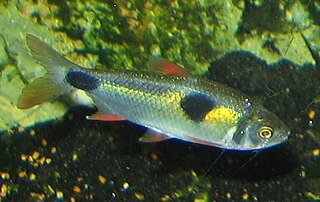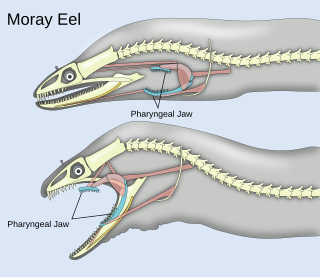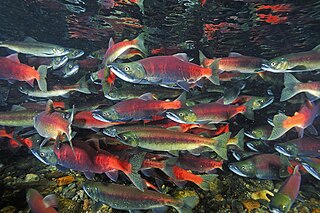Related Research Articles

The wrasses are a family, Labridae, of marine fish, many of which are brightly colored. The family is large and diverse, with over 600 species in 81 genera, which are divided into 9 subgroups or tribes. They are typically small, most of them less than 20 cm (7.9 in) long, although the largest, the humphead wrasse, can measure up to 2.5 m (8.2 ft). They are efficient carnivores, feeding on a wide range of small invertebrates. Many smaller wrasses follow the feeding trails of larger fish, picking up invertebrates disturbed by their passing. Juveniles of some representatives of the genera Bodianus, Epibulus, Cirrhilabrus, Oxycheilinus, and Paracheilinus hide among the tentacles of the free-living mushroom corals & Heliofungia actiniformis.

Moray eels, or Muraenidae, are a family of eels whose members are found worldwide. There are approximately 200 species in 15 genera which are almost exclusively marine, but several species are regularly seen in brackish water, and a few are found in fresh water.

Elasmobranchii is a subclass of Chondrichthyes or cartilaginous fish, including sharks, rays, skates, and sawfish. Members of this subclass are characterised by having five to seven pairs of gill clefts opening individually to the exterior, rigid dorsal fins and small placoid scales on the skin. The teeth are in several series; the upper jaw is not fused to the cranium, and the lower jaw is articulated with the upper. The details of this jaw anatomy vary between species, and help distinguish the different elasmobranch clades. The pelvic fins in males are modified to create claspers for the transfer of sperm. There is no swim bladder; instead, these fish maintain buoyancy with large livers rich in oil.

The Anostomidae are a family of ray-finned fishes that belong to the order Characiformes. Closely related to the Chilodontidae and formerly included with them, the Anostomidae contain about 150 described species. Commonly known as anostomids, they are found in freshwater habitats from the Río Atrato in northernmost South America to warm-temperate central Argentina; they are of Amazon origin, with few found west of the Andes. Their scientific name approximately means "mouth on top", from Ancient Greek áno- (ἄνω) "up" + stóma (στόμᾶ) "mouth", in reference to the arrangement of these fishes' mouth opening.

Fangtooths are beryciform fish of the family Anoplogastridae that live in the deep sea. The name is from the Greek anoplo, meaning "unarmed", and γαστήρ, meaning "stomach". With a circumglobal distribution in tropical and cold-temperate waters, the family contains only two very similar species in one genus, with no known close relatives.

Placodermi is a class of armoured prehistoric fish, known from fossils, which lived from the Silurian to the end of the Devonian period. Their head and thorax were covered by articulated armoured plates and the rest of the body was scaled or naked, depending on the species. Placoderms were among the first jawed fish; their jaws likely evolved from the first of their gill arches.

The pumpkinseed, also referred to as pond perch, common sunfish, punkie, sunfish, sunny, and kivver, is a small/medium-sized North American freshwater fish of the genus Lepomis, from family Centrarchidae in the order Perciformes.

Character displacement is the phenomenon where differences among similar species whose distributions overlap geographically are accentuated in regions where the species co-occur, but are minimized or lost where the species' distributions do not overlap. This pattern results from evolutionary change driven by biological competition among species for a limited resource. The rationale for character displacement stems from the competitive exclusion principle, also called Gause's Law, which contends that to coexist in a stable environment two competing species must differ in their respective ecological niche; without differentiation, one species will eliminate or exclude the other through competition.

The Utah sucker is a species of freshwater fish in the family Catostomidae found in the upper Snake River and the Lake Bonneville areas of western North America where it lives in a wide range of habitats. It is a large sucker growing up to 25 in (64 cm) long. It is generally blackish above, vaguely streaked and blotched, with a white belly. A narrow rosy lateral band extends backwards from the head. The mouth has thick lips and is on the underside of the head. Some populations are in decline because of anthropogenic factors but overall this fish is not threatened.

The shortjaw cisco is a North-American freshwater whitefish in the salmon family. Adult fish range to about 30 cm (12 in) in length and are silver, tinged with green above and paler below. One of the members of the broader Coregonus artedi complex of ciscoes, it is distributed widely in the deeper lakes of Canada, but populations in the Great Lakes have been declining and it is no longer present in Lakes Michigan, Huron, and Erie. It feeds mainly on crustaceans and insect larvae and spawns in the autumn on the lake bed. It is part of the important cisco (chub) fishery in the Great Lakes. The International Union for Conservation of Nature has rated its conservation status as "vulnerable". Shortjaw cisco have however evolved from the cisco Coregonus artedi independently in different lakes and different parts of the range, and conservation assessments therefore should be made on a lake-wise rather than range-wide basis.

Lepidophagy is a specialised feeding behaviour in fish that involves eating the scales of other fish. Lepidophagy is widespread, having evolved independently in at least five freshwater families and seven marine families. A related feeding behavior among fish is pterygophagy: feeding on the fins of other fish.

Loricarioidea is a superfamily of catfishes. It contains the six families Trichomycteridae, Nematogenyiidae, Callichthyidae, Scoloplacidae, Astroblepidae, and Loricariidae. Some schemes also include Amphiliidae. This superfamily, including Amphiliidae, includes about 156 genera and 1,187 species.

Pharyngeal jaws are a "second set" of jaws contained within an animal's throat, or pharynx, distinct from the primary or oral jaws. They are believed to have originated as modified gill arches, in much the same way as oral jaws. Originally hypothesized to have evolved only once, current morphological and genetic analyses suggest at least two separate points of origin. Based on connections between musculoskeletal morphology and dentition, diet has been proposed as a main driver of the evolution of the pharyngeal jaw. A study conducted on cichlids showed that the pharyngeal jaws can undergo morphological changes in less than two years in response to their diet. Fish that ate hard-shelled prey had a robust jaw with molar-like teeth fit for crushing their durable prey. Fish that ate softer prey, on the other hand, exhibited a more slender jaw with thin, curved teeth used for tearing apart fleshy prey. These rapid changes are an example of phenotypic plasticity, wherein environmental factors affect genetic expression responsible for pharyngeal jaw development. Studies of the genetic pathways suggest that receptors in the jaw bone respond to the mechanical strain of biting hard-shelled prey, which prompts the formation of a more robust set of pharyngeal jaws.
Ecomorphology or ecological morphology is the study of the relationship between the ecological role of an individual and its morphological adaptations. The term "morphological" here is in the anatomical context. Both the morphology and ecology exhibited by an organism are directly or indirectly influenced by their environment, and ecomorphology aims to identify the differences. Current research places emphasis on linking morphology and ecological niche by measuring the performance of traits associated behaviours, and fitness outcomes of the relationships.

Aquatic feeding mechanisms face a special difficulty as compared to feeding on land, because the density of water is about the same as that of the prey, so the prey tends to be pushed away when the mouth is closed. This problem was first identified by Robert McNeill Alexander. As a result, underwater predators, especially bony fish, have evolved a number of specialized feeding mechanisms, such as filter feeding, ram feeding, suction feeding, protrusion, and pivot feeding.
"Crocodylus" megarhinus is an extinct species of crocodile from the Eocene of Egypt. A partial skull was found by British paleontologist Charles William Andrews in the Fayum Depression. Andrews named Crocodylus megarhinus in 1905 on the basis of the holotype skull. A complete skull was also uncovered from Egypt in 1907 but was not recognized as "C." megarhinus until 1927.

Most bony fishes have two sets of jaws made mainly of bone. The primary oral jaws open and close the mouth, and a second set of pharyngeal jaws are positioned at the back of the throat. The oral jaws are used to capture and manipulate prey by biting and crushing. The pharyngeal jaws, so-called because they are positioned within the pharynx, are used to further process the food and move it from the mouth to the stomach.

Paroncheilus affinis, the bigtooth cardinalfish or longtooth cardinalfish, is a species of marine fish in the family Apogonidae and the only member of its genus. The bigtooth cardinalfish lives in the west-central Atlantic, off southern Florida, United States, and from the Bahamas to Venezuela, and as far south as Suriname. This species also is found in the east-central Atlantic and the Gulf of Guinea, and has been reported as far as Cape Verde. It is a pale orangeish colour.

Ostorhinchus doederleini is a species of fish in the cardinalfish family, also known by the common names Doederlein's cardinalfish and fourline cardinalfish. In Japanese it is called osuji-ishimochi. It is native to subtropical regions of the western Pacific Ocean, its distribution extending from Japan to Taiwan and Australia to New Caledonia and the Kermadec Islands.

The kokanee salmon, also known as the kokanee trout, little redfish, silver trout, kikanning, Kennerly's salmon, Kennerly's trout, or Walla, is the non-anadromous form of the sockeye salmon. There is some debate as to whether the kokanee and its sea-going relative are separate species; geographic isolation, failure to interbreed, and genetic distinction point toward a recent divergence in the history of the two groups. The divergence most likely occurred around 15,000 years ago when a large ice melt created a series of freshwater lakes and rivers across the northern part of North America. While some members of the salmon and trout family (salmonids) went out to sea (anadromous), others stayed behind in fresh water (non-anadromous). The separation of the sockeye and the kokanee created a unique example of sympatric speciation that is relatively new in evolutionary terms. While they occupy the same areas and habitats during the breeding season, when ocean-going sockeye salmon return to freshwater to spawn, the two populations do not mate with each other in some regions, suggesting speciation.
References
- ↑ Foster, Kimberly; Bower, Luke; Piller, Kyle (January 2015). "Getting in shape: habitat-based morphological divergence for two sympatric fishes: Habitat-based morphological divergence". Biological Journal of the Linnean Society. 114 (1): 152–162. doi: 10.1111/bij.12413 . S2CID 83248494.